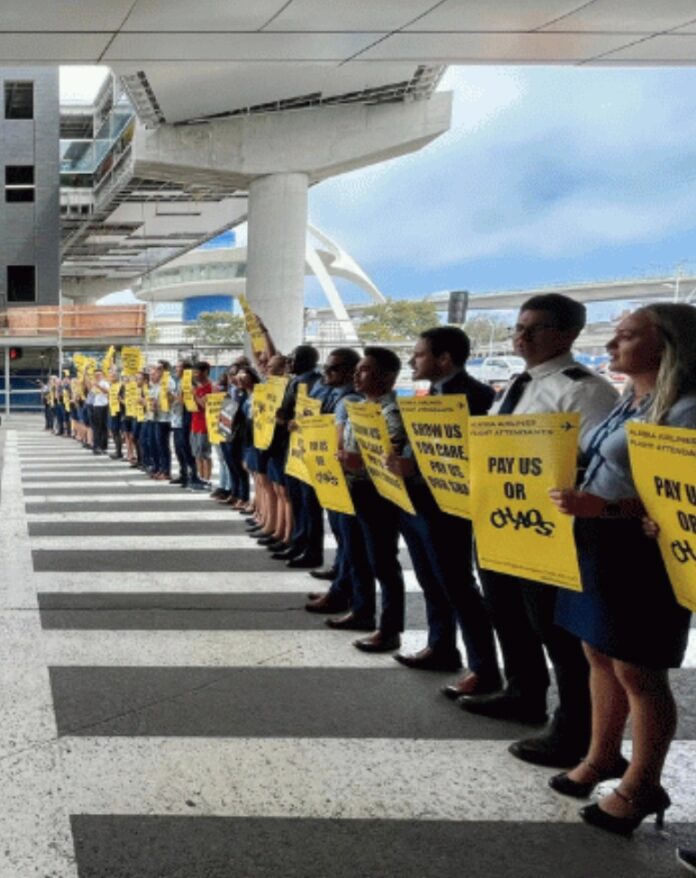Alaska Airlines flight attendants have a tentative agreement with the airline that could avert a strike or work slowdown. The draft contract boosts pay by 32% and also specifies that flight attendants will be paid for the boarding period before the plane takes off. Currently, they are not paid while passengers board, as wages start when the airplane door gets shut.
The three-year contract must be ratified by the Association of Flight Attendants’ Alaska members, who authorized a strike in February. Negotiations have been going on for 20 months. Before the vote, the association will be doing a “road show” to explain the changes to the voting members.
“After an intense week of negotiating at the National Mediation Board, and the clear deadline we set for the company, we have a Tentative Agreement (TA) for a record contract,” The Association of Flight Attendants said last week.
Flight attendants at Alaska Airlines earn between $42,000 and $74,000 a year, with an average of $56,000.

Price increases in 3…2…1…
Then take the Greyhound.
That would be a real bummer if you had to pay a little bit more so these people could have a more competitive wage. Would you prefer they make as little as possible so things are cheap for you?
Looks like that famous quote from Chilkoots is valid and accurate!
… “We cheat the other guy and pass the savings to you.”
Does this mean quality of service will improve?
No, that’s too much to wish for.
Expect ticket prices to follow….. albeit that is close to what our grocery bill has increased in the past few years. Lastly it seems more and more flight attendants have had to add ‘bouncer’ to their list of the myriad of job duties they perform.
What we really need, at least in Southeast, is more airline competition. Monopolies are the worst thing for consumers. To promote competition, the IRS should require airlines to issue Form-1099s to each passenger for the value of the airline miles they receive. Mileage plans lock the market for monopolies. Although they seem beneficial, the mileage plans stifle competition for a net greater cost of travelling to consumers.
Every so often Delta tries and fails. We just don’t have the population to support two carriers.
Wayne, Alaska Airlines makes a decent profit in Southeast, it also provides good service throughout the region.
It turns out that many other Airlines have attempted to operate out of Southeast over the years and all have left the market or folded their tent like MarkAir did Why? Is it because of the limited market? Is it because it’s expensive to operate in Juneau or Sitka?
I say be grateful for the decent service you get from Ak- Air, it could be worse.
The only good thing left with Alaska Air are their flight attendants. The CEO has spent more time on boxed water everyone hates and ensuring DEI is enforced than on customer service. From someone who usually does not support unions, this one I do. Flights are already ridiculously high and at least now it will go to all the flight attendance!
Do the math – 32% is only about an additional $10/hour for the average Stew, with an additional 3 hours of paid work per day that they now perform for free. Good for the Stews, I’m glad that they are getting a better deal – though still not a great deal. If they work full time, $56K is only $27/hour – add 32% and get $35.64/hour – still hard to live on so “little” thanks to bidenflation!
What will this cost per passenger? Airline cost increase per passenger, legal fees, taxes, benefits, union, and management… will add approximately $10.00 to the cost of your average AKAir ticket. Expect the average ticket price to jump at least 25%, the Stews get blamed for it, and profit gouging resulting in a net gain in stock price. This is what happens in a monopoly structure aided by communism. My numbers are estimates, but likely close… Glad I’m now an infrequent flyer…
Well, here we go again people get raises and businesses raise prices to cover the increase of jobs. This is a Ponzi scheme as wages go up as inflation goes up. Gas used to cost $.50 a gallon, but wages were two dollars an hour. It’s all relative let’s give everybody big raises and everybody make $150,000 a year and see what happens to prices.